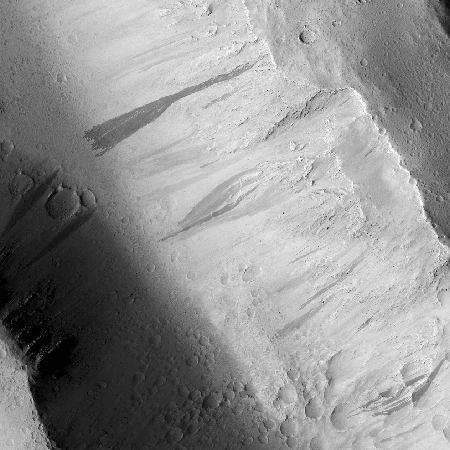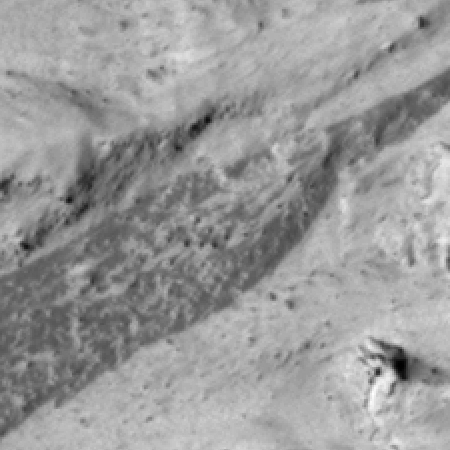A dark dust avalanche on Mars


Cool image time! The two images to the right, both cropped to post here, were taken six years apart by Mars Reconnaissance Orbiter (MRO) of the western lava slopes of the giant volcano Olympus Mons. They show the appearance of a dark dust avalanche during the interim. As noted by members of the MRO science team.
Dust avalanches create slope streaks that expose darker materials usually hidden below a lighter-toned layer. Cascading fine-grained material easily diverts around boulders or alters direction when encountering a change in slope. The dark steak … is approximately 1 kilometer in length that we didn’t see in a previous image. Past avalanche sites are still visible and fading slowly as dust settles out of the atmosphere and is deposited on the dark streaks over time.
We also see boulders and their shadows that are a meter or greater in size. Movement of any of these boulders down the slope could trigger future avalanches.
The appearance of these Martian dark streaks on slopes is actually not uncommon. As more pictures are taken of Mars scientists are beginning to accumulate a large number all across the Martian surface.
What I find fascinating is the wet look of these dark streaks. Below is a close-up of the new avalanche, near its head.

The avalanche itself is not wet, but in many ways it acts like it is. Underground ice might be involved in initiating events, but it is not water that is flowing downhill but dirt and dust. The theory is that the avalanche disturbs surface material, darkening it. Over time the darkening fades, as indicated by the other fading avalanches nearby. The close-up to the right, cropped to post here, shows this. Where large boulders blocked the flow downhill, the ground remained lighter.
While avalanches on Mars will function much like they do on Earth, the lighter gravity as well as the alien environment, will change things. These dark avalanches give us a hint of those differences.
On Christmas Eve 1968 three Americans became the first humans to visit another world. What they did to celebrate was unexpected and profound, and will be remembered throughout all human history. Genesis: the Story of Apollo 8, Robert Zimmerman's classic history of humanity's first journey to another world, tells that story, and it is now available as both an ebook and an audiobook, both with a foreword by Valerie Anders and a new introduction by Robert Zimmerman.
The print edition can be purchased at Amazon or from any other book seller. If you want an autographed copy the price is $60 for the hardback and $45 for the paperback, plus $8 shipping for each. Go here for purchasing details. The ebook is available everywhere for $5.99 (before discount) at amazon, or direct from my ebook publisher, ebookit. If you buy it from ebookit you don't support the big tech companies and the author gets a bigger cut much sooner.
The audiobook is also available at all these vendors, and is also free with a 30-day trial membership to Audible.
"Not simply about one mission, [Genesis] is also the history of America's quest for the moon... Zimmerman has done a masterful job of tying disparate events together into a solid account of one of America's greatest human triumphs."--San Antonio Express-News


Cool image time! The two images to the right, both cropped to post here, were taken six years apart by Mars Reconnaissance Orbiter (MRO) of the western lava slopes of the giant volcano Olympus Mons. They show the appearance of a dark dust avalanche during the interim. As noted by members of the MRO science team.
Dust avalanches create slope streaks that expose darker materials usually hidden below a lighter-toned layer. Cascading fine-grained material easily diverts around boulders or alters direction when encountering a change in slope. The dark steak … is approximately 1 kilometer in length that we didn’t see in a previous image. Past avalanche sites are still visible and fading slowly as dust settles out of the atmosphere and is deposited on the dark streaks over time.
We also see boulders and their shadows that are a meter or greater in size. Movement of any of these boulders down the slope could trigger future avalanches.
The appearance of these Martian dark streaks on slopes is actually not uncommon. As more pictures are taken of Mars scientists are beginning to accumulate a large number all across the Martian surface.
What I find fascinating is the wet look of these dark streaks. Below is a close-up of the new avalanche, near its head.

The avalanche itself is not wet, but in many ways it acts like it is. Underground ice might be involved in initiating events, but it is not water that is flowing downhill but dirt and dust. The theory is that the avalanche disturbs surface material, darkening it. Over time the darkening fades, as indicated by the other fading avalanches nearby. The close-up to the right, cropped to post here, shows this. Where large boulders blocked the flow downhill, the ground remained lighter.
While avalanches on Mars will function much like they do on Earth, the lighter gravity as well as the alien environment, will change things. These dark avalanches give us a hint of those differences.
On Christmas Eve 1968 three Americans became the first humans to visit another world. What they did to celebrate was unexpected and profound, and will be remembered throughout all human history. Genesis: the Story of Apollo 8, Robert Zimmerman's classic history of humanity's first journey to another world, tells that story, and it is now available as both an ebook and an audiobook, both with a foreword by Valerie Anders and a new introduction by Robert Zimmerman.
The print edition can be purchased at Amazon or from any other book seller. If you want an autographed copy the price is $60 for the hardback and $45 for the paperback, plus $8 shipping for each. Go here for purchasing details. The ebook is available everywhere for $5.99 (before discount) at amazon, or direct from my ebook publisher, ebookit. If you buy it from ebookit you don't support the big tech companies and the author gets a bigger cut much sooner.
The audiobook is also available at all these vendors, and is also free with a 30-day trial membership to Audible.
"Not simply about one mission, [Genesis] is also the history of America's quest for the moon... Zimmerman has done a masterful job of tying disparate events together into a solid account of one of America's greatest human triumphs."--San Antonio Express-News


I have noticed that in many locations these dark streaks tend to originate from from the same level up the crater/hillside wall… Typically a few tens of meters from the top.
This indicates to me that there is something lurking at a particular depth involved in the creation of the flows… And the first thought that springs to mind is “water table”
I know it’s all very alien, and I’m probably wrong, but we really need to go take a closer look. Hopefully if the drone on the 2020 rover works out, the technology can be used in future missions to go and get a close up view.
Lee S: I do not know many specifics, but I am aware that among scientists who study Mars’s geology they now refer to something they call the “ice table.” This is equivalent to a water table, but since the water is not liquid they refer to it as ice.
Much of the present research is to determine how deep below the surface this ice table is, as well as how far into the lower latitudes it exists.
Is this related to frozen carbon dioxide changing phase?
@ Bob…
That makes nothing but sense… ( It’s easy to be an armchair planetary geologist!)
But if there is a layer of ice from a long frozen water table, it would stand to reason exposed areas would boil off in the summer and disturb the soil ( regolith? )
I’ve been fascinated by this phenomenon since the first good pictures emerged ( Mars Express if I recall correctly..)
Whatever the cause… They are a reminder of how little we understand about this alien environment!
@ Wayne..
After far as I am aware, the CO2 deposits are surface deposits over the poles, advancing and receding with the seasons.. mainly in the (relatively) surface layers…
I can’t imagine why frozen CO2 would deposit so deep underground… But as I said.. it’s alien geology… So who knows?
So very interesting! :-)